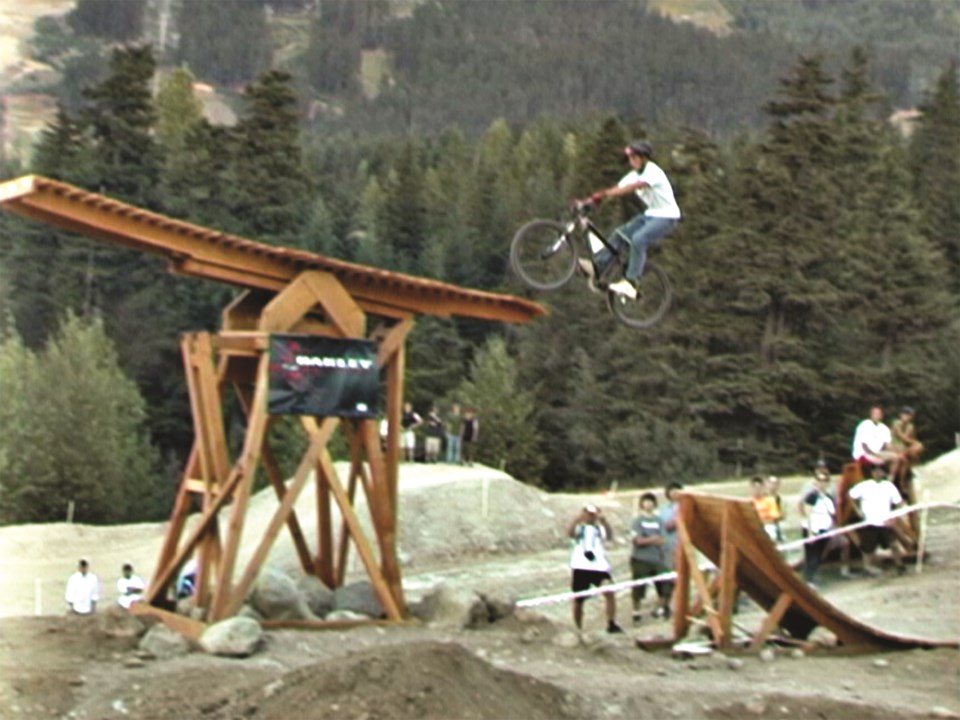Eighteen years ago, the first Crankworx was held in Whistler Village to roaring success. As the Crankworx World Tour is back in town this month, we are throwing back to the original Crankworx Mountain Bike Festival, which started in Whistler in 2004.
We cannot talk about the start of Crankworx without first mentioning Joyride and the Whistler Summer Gravity Festival. Joyride Bikercross was first organized by Chris Winter and Paddy Kaye in 2001. Four riders simultaneously jockeyed for the lead at full speed down a course featuring tight turns and fast jumps. It instantly drew the crowds. Joyride continued in 2002, then was incorporated into the week-long Whistler Gravity Festival in 2003—combining all the disciplines of gravity-assisted mountain biking, including Air Downhill and Slopestyle. In 2004, the Whistler Gravity Festival rebranded to Crankworx.
Crankworx started as a way to pull together all gravity-assisted mountain bike disciplines and events, bringing the best mountain bikers together. The idea was also to showcase the bike park. Rob McSkimming, who was the managing director of the Whistler Mountain Bike Park at the time, approached Mark ‘Skip’ Taylor, who had experience working on the World Ski and Snowboard Festival. According to McSkimming, in 2004, “Crankworx was designed so we could strive to be on the progressive edge of mountain biking.”
In 2004, Crankworx took place July 22 to 25, with concerts, pro-rider shows and an expo throughout the four days. Events included the Air Downhill along A-Line, which was then in its third year. The bike park had newly opened the terrain to the top of Garbanzo, and the Garbanzo Downhill was another signature event, along with the BC Downhill Championship and the Biker X.
Definitely the most popular for spectators was the Slopestyle. The course, which Richie Schley helped design, featured a road gap, wall ride, massive teeter-totter, a step-up to scaffolding, and huge gap jumps and drops. Prior to the event, McSkimming said of the course: “You should see what they are building for the Slopestyle session. It looks like an Olympic facility. There are some features in there that are hard to imagine riding, let alone throwing tricks on.”
There were many memorable moments during the competition. Kirt Voreis left an impression, falling off his bike on top of the teeter-totter. He was able to keep both himself and the bike on the teeter-totter and continue the run after the fall.
Spectators will also remember Timo Pritzel from Germany who went really big, massively overshooting the fun-box transition near the bottom of the course and flying over the scaffolding. As the Whistler Question explained, “He did clear the scaffold, but bailed his bike in mid-air and landed the old-fashioned way, which looked to most of the spectators like a guy jumping out of a two-story building.” He broke his wrist and ankle in the crash, and placed second in the competition.
In an impressive underdog story, Paul Basagoitia took top honours in the 2004 Slopestyle when he was only 17 and still relatively unknown. He had a background in BMX, no sponsors and no bike, so he borrowed a bike from friend, Cam Zink, and went on to win the contest. In an interview with Pique Newsmagazine at the time, he said, “It was awesome, it was only like my fifth time on a mountain bike, so I couldn’t be happier.”
Still on the progressive edge of mountain biking, the evolution of the Crankworx from 2004 to today is evident in the village this week. Whistler has again come alive in celebration of all things mountain biking and no doubt legends will continue to be created.




